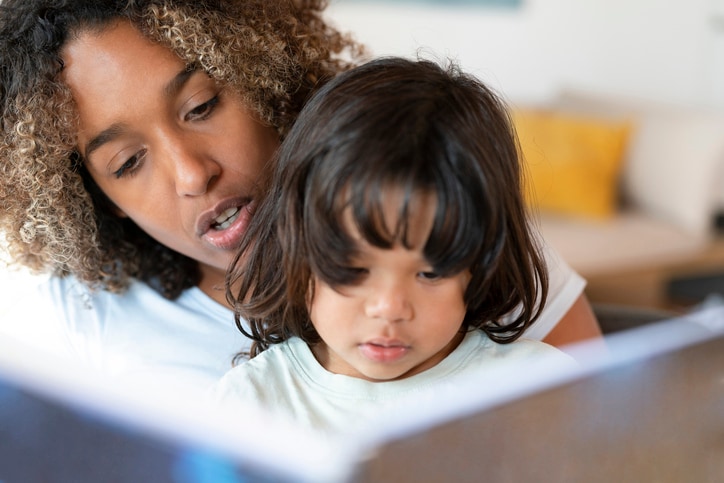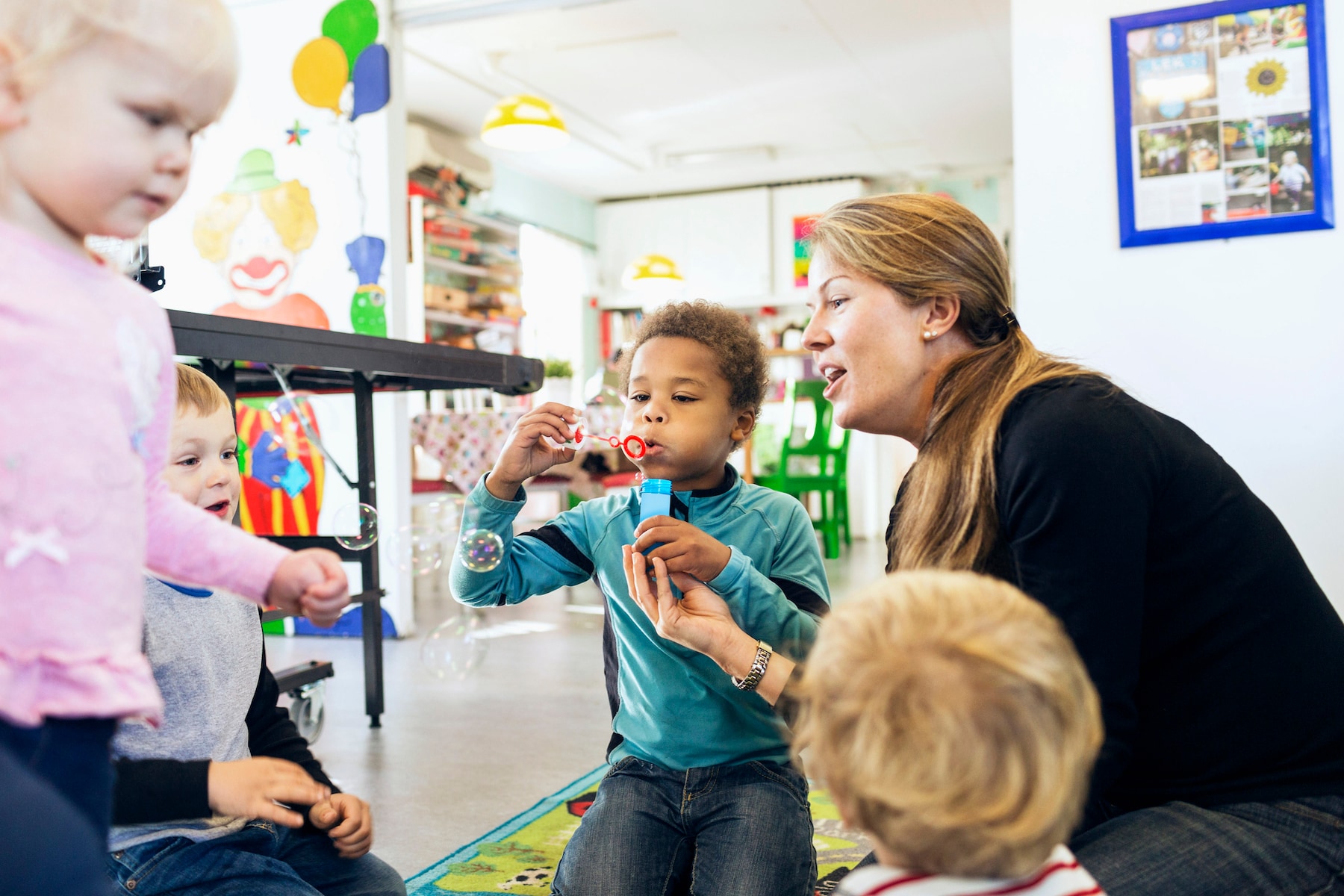Whether you’re balancing raising kids and aging parents simultaneously (aka a sandwich generation caregiver) or looking for a unique child care or senior care setup (or both), an intergenerational care program may be the perfect solution.
Intergenerational care centers provide care for both older adults and children, explains Merle Griff, founder and CEO of SarahCare, who’s also director of the McKinley Center Intergenerational Project and the author of “Solace in the Storm.” “It’s also referred to as a ‘shared site,’” she notes. “In many cases, there’s a senior area on one side of the building and a child care area on the other and a hallway connecting the two. At various points during the day, they come together.”
Wondering if intergenerational care is right for your family? Read on to learn more about the benefits of and options for this unique type of care.
What is intergenerational care?
Intergenerational care can take on a number of forms, but at its core, it’s a program or service that’s offered concurrently to multiple generations with the purpose of fostering meaningful cross-age relationships, explains Sheri Steinig, director of Strategic Initiatives and Communications at Generations United.
“It brings younger and older people together to increase social connectedness, enhance well-being for the benefit of all ages and strengthen the web of support that is so integral to families and communities,” Steinig says. “People of different ages come together to learn, play, grow and interact in planned intergenerational activities as well as through informal encounters.”
Types of intergenerational care
The term “intergenerational care” means just that — the care and coming together of multiple generations. However, it varies in form.
“There are many settings for intergenerational care,” Steinig notes. “There can be programs at community centers and schools or care in daycare centers, retirement communities, nursing homes or assisted living and affordable housing.”
That being said, there’s a difference between intergenerational care programs and intergenerational care centers.
Intergenerational programs
Intergenerational care programs, Griff explains, are structured set-ups between kids (of varying ages) and older adults.
“Intergenerational programs are designed to build relationships between seniors and children,” she says. “It’s not daily care in the same building, but instead can be a pen pal program between elementary school kids and seniors; college students having scheduled nursing home visits; choir programs; or older adults who lived through WWI going to schools to talk about their experience.”
To find an intergenerational program in your area, you can utilize Generations United search tool, which shows locations and programs throughout the country.
“There are many settings for intergenerational care. There can be programs at community centers and schools or care in daycare centers, retirement communities, nursing homes or assisted living and affordable housing.”
— Sheri Steinig, director of Strategic Initiatives and Communications at Generations United
Intergenerational care centers (shared sites)
On the other hand, intergenerational care centers are day care centers or preschools that are in the same location as a nursing home, adult day care center, etc. These are sometimes referred to as intergenerational day centers (IDC). Their presence, it’s worth noting, is far less robust than that of intergenerational programs. (As of 2021, there were only 150 shared sites in the U.S.)
“Each center is run their own way, but there are always separate entrances, which protects both older adults, as well as children — particularly during sick seasons,” Griff explains. (Also, think: running kids and older adults with walkers.) “Then, there are typically planned, structured interactions during the day.” (They’re not, it should be noted, in the same area/location the whole day.)
Common shared site set-ups, per Generations United may look like:
- Adult day care and child care program housed in the same facility.
- Senior center located in a school.
- After school programs held at a senior center.
- Child care in a long term care facility.
- Head Start program in a nursing home.
The activity they come together for, as well as the duration of time, Griff notes, often depends on kids’ ages. “With preschoolers, we generally keep it to a 30-45 minute group activity. Activities with school-aged kids are about the same amount of time, but typically they’re one-on-one.”
Per Griff, daily intergenerational activities at centers may be:
- Beach ball volleyball.
- Arts and crafts and art shows.
- Comparing amusement parks then and now.
- Rock-a-baby. “This was a successful program we ran,” she says. “Seniors had the chance to cuddle and rock newborn babies to sleep. And interestingly, more men participated, as they felt they had missed out in their younger years.”
The cost of an intergenerational care center is in line with standard child/senior care prices, adds Griff.
To find an intergenerational shared site in your area, you can utilize Generations United search tool, which shows locations throughout the country.
Multigenerational households
Still another example of intergenerational care is a multigenerational household, where more than two generations live. According to Generations United, one in four households in America is multigenerational. The most common set-up, they note, is the three-generational household from the same family (also known as the sandwich generation).
Intergenerational care benefits
“We’ve always had positive outcomes with our programs,” Griff notes. “The older adults are often so patient and approving with the kids, delighting in their artwork and projects. And moreso, they’re getting a sense of purpose and renewal.”
And on the other end, she notes, kids who once had biases about “senior citizens” with walkers and wheelchairs completely dissipate after spending time with them. “They’re no longer uncomfortable or awkward around older adults.”
Here’s a clip from the intergenerational documentary, “The Growing Season,” that illustrates the connections kids and seniors can make through these programs:
The benefits of intergenerational care are plentiful for “children, older adults, parents and caregivers, staff, sponsoring organizations and communities,” Steinig says. Several examples:
Intergenerational benefits for kids
According to Steinig, children who experience intergenerational care show:
- Improved self-esteem and self-confidence.
- Enhanced communication skills (e.g., listening, expressing feelings).
- Improved fine and gross motor skills.
- Increased understanding of older adults and aging.
- Improved vocabulary and reading.
- Better eye-hand coordination.
- Enhanced mood.
- Increased ability to cooperate and problem-solve.
- Increased appreciation of diversity (e.g., age, disability).
- Increased comfort interacting with older adults.
- Improved academic skills.
Intergenerational benefits for older adults
Older adults in intergenerational care enjoy the following, says Steinig:
- Enhanced life satisfaction/well-being.
- Enhanced problem-solving skills.
- Increased physical activity.
- Increased self-esteem/self-worth.
- Enhanced communication skills.
- Increased brain stimulation.
- Reduced feelings of loneliness.
- Decreased depression.
- Increased comfort with technology.
- Increased socialization and engagement.
- Increased confidence.
The bottom line
The benefits of both intergenerational programs and intergenerational shared sites are vast for both older adults and children. “The kids are always very responsive in these types of programs and set-ups,” says Griff.
Further, she adds, seniors feel that they’re offering care, not just receiving care, which offers them a sense of purpose. “And in return, they’re getting meaningful interactions, including hugs from the kids,” notes Griff. “This goes a long way.”





